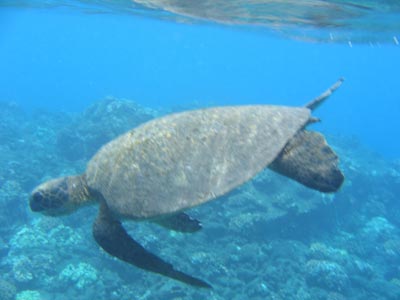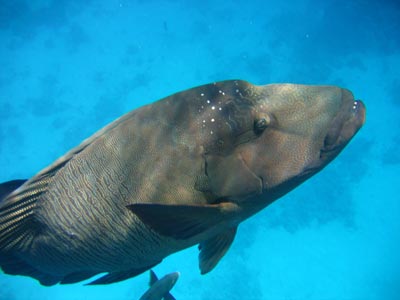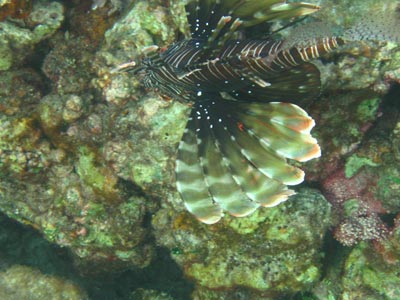Around the world: seven outstanding snorkeling spots
by Larry Taylor, Fullerton, CA
My wife and I are avid snorkelers and we have snorkeled in various spots all over the world. With this in mind, I decided to write about our seven best snorkeling experiences in the areas of the world that ITN covers. Be aware that these selections are very subjective.
What I looked for in choosing these places was not necessarily the quantity and variety of fish seen but the quality of the total experience, including the beach and coral environment.
For example, a place with a great stretch of sand might rank over an area where we had to painfully tiptoe through rocks to enter the water. Also, snorkeling on a boat excursion would be chosen only if the experience was unique.
Considering all of that, here is the list.
NORMAN REEF, AUSTRALIA
When we came to the Great Barrier Reef, stretching about 1,250 miles along the northeast coast of Australia, we knew of its reputation for having the best diving and snorkeling in the world. We weren’t disappointed.
As the barrier reef is not accessible from the shore, we took a trip from Cairns with Great Adventures (P.O. Box 898, Cairns, Queensland, Australia 4870; phone 07 4044 9944, www.greatadventures.com.au), an easy way to reach the reef. A high-speed catamaran carried us some 40 miles out to a unique pontoon, a large, 135-by-45-foot covered platform equipped with tables, chairs and a restaurant. Other amenities included a dive shop and, of course, a souvenir shop — all the comforts of home.
Once there, it was a short swim out to the spectacular coral shelf and the creatures living on it, including every manner of tropical fish and even giant clams. Greeting us when we returned to the float was “Sammy,” a large 6-foot Maori wrasse — a daily ceremony, we were told.
We were in and out of the water a couple times and had lunch, staying there in total for three hours. For those who don’t want to get wet, there are an underwater observatory and a semisubmersible submarine from which to view the reef life.
The current price for the 3-hour Great Barrier Reef Adventure tour is AU$174 (US$149) per adult.
REPUBLIC OF PALAU, MICRONESIA
Palau is an archipelago of over 400 islands and about 20,000 citizens. The overused word “unspoiled” comes to mind, but it is completely appropriate when describing this country. When we traveled there in May ’07, what first overwhelmed us while snorkeling was the coral, over 500 species of multicolored hard and soft varieties — a painter’s palette of colors close up.
Fish, too, were present in staggering numbers. With over 1,400 species of fish, Palau was recently named the Number One Underwater Wonder of the World by CEDAM International, a group of marine scientists and conservationists.
To see as much as possible, we recommend hiring a boat with a guide, such as Ron Leidich (e-mail planet blue@palaunet.com), whom we used. A guide knows where to go and can provide information about everything Palauan: the flora, fauna and geography and even the Japanese World War II sites, which abound in the area.
Once on board, we headed for the Rock Islands, a collection of rounded foliage-covered islets. Undercut by wave action, these limestone formations seem to fl oat above the surface of the water.
This area is snorkeling heaven, with channels wending throughout plus, in places, landlocked lakes which can only be entered through tunnels or by trails.
Reaching famed Jellyfish Lake, for example, requires a hike up from the shore. Closed off from the ocean, the large milky pond has become a habitat for the “stingless” jellyfi sh, with virtually no predators. The jellies pulsate through the water, and swimming among the mass was like gliding through a porous, pinkish-gold curtain.
Other swimming spots included Giant Clam Beach, Lolita’s Coral Gardens and Ulong Island, where “Survivor” took place a couple years ago. The list of spots to visit goes on, and we wished we had another week there.
Contact Palau Visitors Authority (P.O. Box 256, Koror, Republic of Palau 96940; www.visit-palau.com).
THE RED SEA — SAFAGA, EGYPT
For divers and snorkelers, the Red Sea is high on the list of places to go. One of the most famous resort cities is Sharm el-Sheikh on the Sinai Peninsula, but, having been to Sharm el-Sheikh, we prefer Safaga, Egypt, to the south. It is not nearly as crowded and it is much easier to get out to a reef from there. Also a point for sightseeters to consider — it’s only a few hours’ drive from Safaga to Luxor, on the Nile, the celebrated destination to see ancient temples and royal tombs.
At Soma Bay, right outside town, there is a long pier extending about a hundred yards out. We entered the beach through the Sheraton Soma Bay Resort. (For those not staying at the resort, it’s a good value to pay a small day fee, about $15, to use the facilities.) Once at the water’s edge, a short walk took us to the pier.
Here, divers as well as snorkelers enter the water and are immediately in a wonder world of coral and exotic sea life. Interesting is that a lot of the same species seen in the tropics throughout the world can be found here but in different colors. As well, we saw species new to us.
Once in, we were amazed at how clear the water was in the Red Sea.
Clown fish were in abundance, and right away we saw the outrageously bedecked lion fish — a rare sight anywhere, but here he was, swimming languorously among the crowd.
For info, visit www.goredsea.com.
SEYCHELLES ISLANDS
Whatever your conception of a tropical paradise, Seychelles — 115 islands scattered off the African coast east of Kenya — will more than meet it. Stereotypically, wide, palm-lined beaches virtually unspoiled and not overcrowded are the norm.
The capital city, Victoria, is on the most populated of the islands, Mahé. The two easiest islands to reach from there are Praslin, a 20-minute flight away or three hours by ferry, and La Digue, a 30-minute ferry ride from Praslin.
Snorkeling is excellent in both places, especially La Digue, which has some of the most photographed beaches in the world. Its surrealistically shaped granite rocks rising from the shallows like sentinels can be seen in countless fashion ads.
On La Digue’s Anse Source d’Argent beach, we took a short swim to the reef. On the way, we saw an octopus wrapped around a pillar of coral, his tentacles flowing in the current. A little beyond, we came upon a couple of devil scorpion fish on the bottom and were very careful to not touch their poisonous bodies.
We enjoyed our best snorkeling on small Desroches Island, a 50-minute flight from Mahé. Unlike Praslin and La Digue, which have a few places to stay, there is only one small resort there. A walk around the island takes only 20 minutes.
We had one of our greatest-ever snorkel experiences about 50 yards out from the main beach. Once there, we came upon a tower of coral with the most varieties of fish we had ever seen in a small area. They included many of our seldom-seen favorites: the moon-shaped marong fish; the oriental sweetlips, with its black and yellow polka dot patterned fins, and even a lion fish. We were on a “snorkel high” for the rest of the day.
Contact Seychelles Tourism Board
(P.O. Box 1262, Victoria, Mahé, Seychelles; phone +248 671300, www.seychelles.com).
SAN BLAS ISLANDS, PANAMA
San Blas is an archipelago consisting of 365 islands located some 100 miles off the east coast of Panama. Inhabited by Kuna Indians, many of the islands are postage stamp size, with the biggest measuring only a mile around.
The islands are easily accessible after a 20-minute flight from Panama City. Accommodations there are rustic, as would be expected, but it’s a place of quiet nights and bright, sunny days, with pleasant breezes tempering the midday heat.
Kunas welcome visitors, and many offer transportation in their boats to a different uninhabited island each day, each boasting perfect beaches and great snorkeling in warm, clear water. One day we swam over a giant manta ray; on another, we came upon a very large nurse shark (harmless) asleep under a rock.
On the islands, people live much as their ancestors did, in palm-thatched huts with no electricity. Food and water are brought in from the coast. Of course, a Kuna staple is the plentiful supply of sea life. The crab and lobster caught in these waters are the best we’ve ever eaten.
Kuna women are known for their multicolored costumes, which consist of patterned blue skirts, red-and-yellow head scarves, arm and leg beads and intricately sewn mola-paneled blouses.
Molas are handwoven in a reverse appliqué technique which uses several layers of cotton fabric of different colors. (Four-layer designs are the best.) These have become desirable art pieces and a principle source of income for the people.
Indeed, women followed tourists and set up what we called “mola malls” on the beaches. Part of our daily fun was taking a stroll down the line, viewing these wonderful rectangular pieces. Averaging about 18 by 14 inches, they depicted animals, mythic characters and folk symbols. The pieces can cost as little as $10 each, but some sold for up to $80.
The people at EcoVentures (800/7438352, www.ecoventurestravel.com) have much experience helping visitors find the best place to stay based on their desires. A popular island is Uaguitupo, which is small, with few tourists and comfortable accommodations. It has a beautiful beach and offers excellent snorkeling right outside your door.
Guides are available to take guests to visit other islands each day. Whichever island you choose, the fresh seafood is wonderful.
NINGALOO REEF, WEST AUSTRALIA
The Great Barrier Reef comes to mind when snorkelers and divers consider going to Australia, but some 800 miles north of Perth, on the country’s sparsely populated northwestern coast, lies Ningaloo Reef. Nearly 200 miles long, it is one of the largest fringing coral reefs in the world.
And, in contrast to the Great Barrier Reef, it is situated close to the beach, about 100 yards out at its nearest point. However, due to its remoteness, Ningaloo doesn’t have the tourist draw nor the reputation of its eastern counterpart.
Even beginners can swim in the shallows along the reef and see an amazing variety of fish swimming among the more than 200 species of coral — a riotously colorful display. However, reef snorkeling is only one of the big attractions there.
From mid-March to mid-May, snorkelers can swim with whale sharks, the world’s largest fish. Ninagaloo is the only easily accessible place in the world where these gentle giants appear in large numbers at predictable times of the year.
Whale sharks reach a length of more than 36 feet and can weigh more than 11 tons. Swimming close to the surface, they seem to invite people to join them.
Boats leave daily to seek them, and airplanes scout their location. It’s a once-in-a-lifetime experience.
The small towns of Exmouth and Coral Bay are the best places to stay.
Visit www.ningalooreef.net.
HUAHINE, FRENCH POLYNESIA
All of the Polynesian islands have great snorkeling, but we especially like Huahine, 198 miles northwest of Tahiti. The island consists of two volcanic ranges joined by a natural bridge.
It is called the Garden Island due to its lush tropical foliage and jungle-like scenery. A big plus, for us — there were fewer vacationers there than in neighboring Moorea and Bora Bora, giving us a chance to get away from people and explore on our own.
Huahine offers many white-sand beaches off which to snorkel. However, the high point for us came when we took a dive boat which dropped us off into a slight current at an outer reef. We leisurely fl oated through a lagoon, moving effortlessly with the fl ow and taking time to enjoy the fish. To keep us from being swept away, our boat cruised slowly at our side.
Visit www.huahine.com.
JEAN-MICHEL COUSTEAU RESORT, FIJI ISLANDS
Fiji contains some 300 islands, many with top resorts, making it hard to select the right place to visit. High on any list, though, is the Jean-Michel Cousteau Resort (800/246-3454, www.fijiresort.com), particularly if water sports are a premium interest. With the Cousteau name, the diving would have to be good, but the snorkeling, too, was the best.
This award-winning, 5-star resort, situated on 17 acres of what used to be a coconut plantation, is located on Vanua Levu, Fiji’s second-largest island. Surrounded by mountains and reefs, the Cousteau sits at the edge of Savusavu Bay, a well-protected refuge. The buildings are constructed on the theme of a traditional Fijian village, with 25 bures (thatch-roofed bungalows) in various sizes to accommodate couples or families. (Rooms start at $590 for a one-bedroom bure. All meals and most activities are included in the price.)
Every morning the resort boat left with a group of divers, while we snorkelers had several options. Coral and fish could be seen by snorkeling off the little pier in front. As well, a snorkeling boat was available to take guests out. We especially liked the nearby Lighthouse Reef, with deep water on one side where we might spot a large grouper and shallow water on the other with the usual menagerie of smaller tropicals to be seen.
Night snorkeling was also an option. A staff marine biologist would take groups equipped with flashlights off the pier to see the wonders of nighttime on the reef. We particularly sought out our new “friend,” a rare oriental sweetlips, which we found snoozing under a coral ledge.
So there they are, our favorite underwater sports spots. But, as every snorkeler knows, all that is really needed is an expanse of water, a mask and fins. Have fun!




